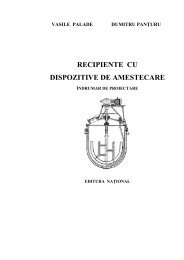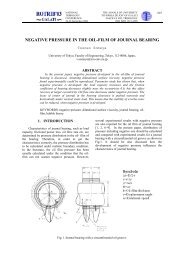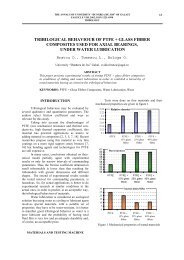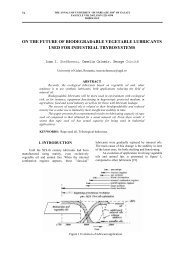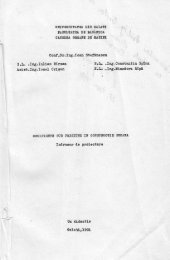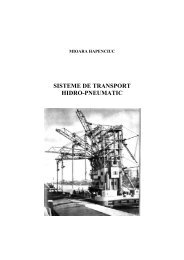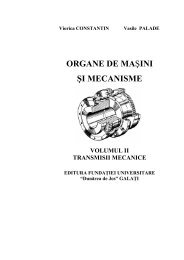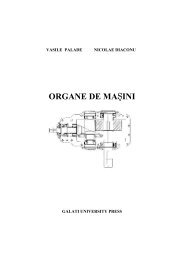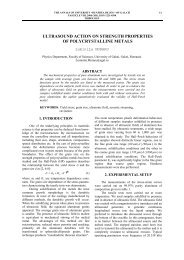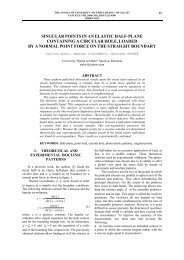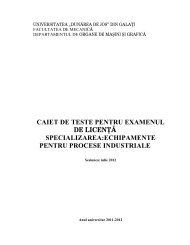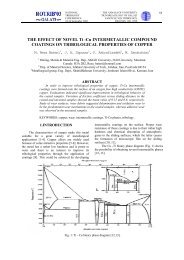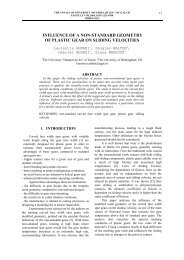flammability test data in risk assessment
flammability test data in risk assessment
flammability test data in risk assessment
Create successful ePaper yourself
Turn your PDF publications into a flip-book with our unique Google optimized e-Paper software.
THE ANNALS OF UNIVERSITY “DUNĂREA DE JOS“ OF GALAŢI<br />
FASCICLE VIII, 2008 (XIV), ISSN 1221-4590<br />
TRIBOLOGY<br />
69<br />
Paper present at<br />
Bucharest, Romania<br />
FLAMMABILITY TEST DATA IN RISK ASSESSMENT<br />
Lorena DELEANU 1) , Dragoş BUZOIANU 2) , Ştefan CRĂCIUNOIU 2) ,<br />
M<strong>in</strong>odora RÎPĂ 1) , Constant<strong>in</strong> SPÂNU 1)<br />
1) University Dunărea de Jos Galaţi, ROMANIA, 2) ICTCM, Bucharest, ROMANIA<br />
lorena.deleanu@ugal.ro<br />
ABSTRACT<br />
This paper reviews the most recent <strong>in</strong>formation on standards deal<strong>in</strong>g with <strong>test</strong><strong>in</strong>g<br />
fire-resistance of hydraulic fluids <strong>in</strong> order to emphasis the importance of select<strong>in</strong>g<br />
hydraulic fluids <strong>in</strong>clud<strong>in</strong>g as basic criteria of reduc<strong>in</strong>g fire <strong>risk</strong> <strong>in</strong> particular<br />
and general <strong>in</strong>dustrial applications, gives <strong>in</strong>formation on an orig<strong>in</strong>al stand for<br />
determ<strong>in</strong><strong>in</strong>g the <strong>flammability</strong> characteristics of fire fluids <strong>in</strong> contact with hot surface<br />
and presents prelim<strong>in</strong>ary results of the <strong>test</strong>s. These <strong>test</strong> results may be <strong>in</strong>cluded <strong>in</strong> a<br />
<strong>risk</strong> <strong>assessment</strong> <strong>in</strong> order to enhance the security and health levels <strong>in</strong> <strong>in</strong>dustry.<br />
Keywords: <strong>flammability</strong> <strong>test</strong>, hydraulic fluid, <strong>risk</strong> <strong>assessment</strong>.<br />
1. INTRODUCTION<br />
Some relevant factors concern<strong>in</strong>g hydraulic<br />
fluid selection are: materials’ compatibility analysed<br />
for the entire system, particular design requirements<br />
(lubricat<strong>in</strong>g, seal<strong>in</strong>g, cool<strong>in</strong>g etc.), price of the selected<br />
hydraulic fluids related to the price of the entire<br />
system <strong>in</strong>clud<strong>in</strong>g ma<strong>in</strong>tenance and fire suppression<br />
mechanisms, operat<strong>in</strong>g temperature range, lubrication<br />
capacity, load capacity, operat<strong>in</strong>g pressure, ma<strong>in</strong>tenance<br />
requirements, health, safety and environmental<br />
requirements, fire-resistance [20, 43].<br />
Select<strong>in</strong>g hydraulic fluids <strong>in</strong>clud<strong>in</strong>g as basic<br />
criteria of reduc<strong>in</strong>g fire <strong>risk</strong> becomes of major <strong>in</strong>terest<br />
<strong>in</strong> particular and general <strong>in</strong>dustrial applications [3-5,<br />
7, 16, 30, 34].<br />
There are several reasons of fluid leak<strong>in</strong>g:<br />
- fatigue of system elements, under severe exploittation<br />
conditions (cracks, creep etc.),<br />
- hot metal <strong>in</strong>creases its dimensions, bolts stretch; hot<br />
fluid exhibits lower viscosity. In new and old systems,<br />
frequent sources of leaks are flanges and hoses [1, 25],<br />
- seals may become <strong>in</strong>efficient due to their property<br />
changes produce by long exposure to temperature<br />
or/and chemicals, but also by trapped solid particles;<br />
- operator faults [1, 25]<br />
- screwups: the tips come from actual case histories [22,<br />
25]; a controlled mount<strong>in</strong>g and operation decrease the<br />
leak probability under function<strong>in</strong>g conditions. Also it is<br />
important to respect procedures characteris<strong>in</strong>g the<br />
open<strong>in</strong>g and stopp<strong>in</strong>g of the equipment.<br />
2. CURRENT STANDARDS ON FIRE-<br />
RESISTANT HYDRAULIC FLUIDS<br />
Table 1 presents the la<strong>test</strong> standards on <strong>test</strong><strong>in</strong>g<br />
fire resistance of the hydraulic fluids <strong>in</strong>clud<strong>in</strong>g EN<br />
ISO 20823: 2003 – Determ<strong>in</strong>ation of the <strong>flammability</strong><br />
characteris-tics of fluids <strong>in</strong> contact with hot surfaces -<br />
Manifold ignition <strong>test</strong>, EN ISO 2592:2001–Determ<strong>in</strong>ation<br />
of flash and fire po<strong>in</strong>ts - Cleveland open cup<br />
method, Approval Standard for Flammability Classification<br />
of Industrial Fluids (Class 6930, 2002) [2],<br />
Factory Mutual Global etc. and their relations to several<br />
European Directives that <strong>in</strong>clude estimation of fire<br />
resistance of the hydraulic fluids and safety for particular<br />
<strong>in</strong>dustries (coal m<strong>in</strong>e, metallurgical plants etc.).<br />
Both manufacturers and users ask for <strong>test</strong>s that<br />
certify fluid <strong>flammability</strong> characteristics, preferr<strong>in</strong>g<br />
especially ISO or ASTM standards. Many documents,<br />
<strong>in</strong>clud<strong>in</strong>g EU Directives, give recommendations to<br />
use standard <strong>test</strong>s for estimat<strong>in</strong>g <strong>flammability</strong> characterisation<br />
of fluids [2-4, 8, 11, 12, 14, 16, 17, 44].<br />
The authors po<strong>in</strong>t out that the qualitative and<br />
quantitative quantification of fire resistance of a<br />
hydraulic fluid could not be done by one property only<br />
and the different aspects of fire resistance have to be<br />
outl<strong>in</strong>ed by different <strong>test</strong>s, <strong>in</strong>clud<strong>in</strong>g <strong>test</strong>s simulat<strong>in</strong>g on
70<br />
THE ANNALS OF UNIVERSITY “DUNĂREA DE JOS“ OF GALAŢI<br />
FASCICLE VIII, 2008 (XIV), ISSN 1221-4590<br />
TRIBOLOGY<br />
small scale the worst scenario that could happen <strong>in</strong> real<br />
applications, when us<strong>in</strong>g hydraulic fluids [2-5, 16-19].<br />
A particularity of many of these <strong>test</strong>s is that the <strong>test</strong><br />
result is delivered as “pass” or “not pass”. The fluids<br />
that passed the <strong>test</strong>s are <strong>in</strong>cluded <strong>in</strong> recommendations<br />
or approvals, but these ones are specific to regional<br />
reglementations (<strong>in</strong> SUA: Approval Guide or List of<br />
Qualified Fluids, <strong>in</strong> European Union: [6, 7, 14, 16] or<br />
<strong>in</strong> national normatives: [3, 13, 15]).<br />
Organizations such as Occupational Safety and<br />
Health Association (OSHA), National Fire Protection<br />
Association (NFPA) and some specialists classify<br />
flammable liquids accord<strong>in</strong>g to their flashpo<strong>in</strong>t [10,<br />
33, 34, 39, 41]. A flashpo<strong>in</strong>t with<strong>in</strong> the operat<strong>in</strong>g<br />
temperature range of the system obviously is<br />
undesirable as any leak would create an immediate<br />
fire hazard [20, 43].<br />
The globalization of hydraulic fluid market<br />
<strong>in</strong>volved studies on exist<strong>in</strong>g and proposed fireresistance<br />
and <strong>flammability</strong> <strong>test</strong>s <strong>in</strong> order that<br />
manufacturers and users of such fluids have common<br />
level of appreciat<strong>in</strong>g and compar<strong>in</strong>g these products,<br />
their applications and possible effects [11, 23].<br />
Sell<strong>in</strong>g <strong>in</strong>to multiple markets is very difficult if each<br />
country or economic community has different<br />
requirements and standards on us<strong>in</strong>g hydraulic fluids.<br />
Many countries and firms subscribe to <strong>in</strong>ternational<br />
standards, but there are important economies as USA,<br />
Japan ones that rely on their own standards, some of<br />
them similar to <strong>in</strong>ternational ones, other ones be<strong>in</strong>g<br />
different. Users require that the products they buy<br />
have to be certified accord<strong>in</strong>g to standards applied <strong>in</strong><br />
their country. These have substantial f<strong>in</strong>ancial<br />
implications concern<strong>in</strong>g expenses on laboratories and<br />
<strong>test</strong> procedures, for both manufacturer and users [10,<br />
40, 44]. The hydraulic fluid manufacturers have few<br />
possibilities for comply<strong>in</strong>g this challenge: mak<strong>in</strong>g<br />
different products for different markets, mak<strong>in</strong>g a<br />
s<strong>in</strong>gle product that passes multiple <strong>test</strong>s (tak<strong>in</strong>g <strong>in</strong>to<br />
account the potential of a cost disadvantage),<br />
select<strong>in</strong>g only some of the potential markets<br />
(<strong>in</strong>ternational or domestic) accept<strong>in</strong>g the <strong>risk</strong> of not<br />
be<strong>in</strong>g a “global” producer.<br />
The laboratories deal<strong>in</strong>g with <strong>flammability</strong> and<br />
fire-resistance properties have the advantage that<br />
more <strong>test</strong>s implies more work, visibility and of<br />
course, money but it also requires disadvantages as:<br />
larger <strong>in</strong>vestment <strong>in</strong> equipment, a greater understandd<strong>in</strong>g<br />
of similarities and differences among<br />
related <strong>test</strong>s (<strong>in</strong>clud<strong>in</strong>g well-tra<strong>in</strong>ed specialists),<br />
agreements for cross-border acceptance of the<br />
results [19, 20, 27].<br />
The development of fire-resistant hydraulic<br />
fluids required the identification of <strong>test</strong> methods that<br />
could reproducibly differentiate the fire-resistance of<br />
the fluids <strong>in</strong> a manner that would relate to real<br />
<strong>in</strong>dustrial conditions [1, 25, 40]. Z<strong>in</strong>c elaborated a<br />
classification of types of fire <strong>test</strong>s [44] accord<strong>in</strong>g to<br />
four elements (fig. 1):<br />
- the fire resistant property that is be<strong>in</strong>g measured<br />
as there are several different facets of fire resistance<br />
and a <strong>test</strong> can measure one or more of them,<br />
- the ignition source used <strong>in</strong> the <strong>test</strong> (almost all<br />
fire resistance <strong>test</strong>s ignite or attempt to ignite the fluid<br />
dur<strong>in</strong>g the <strong>test</strong>),<br />
- the state of the fluid dur<strong>in</strong>g the <strong>test</strong>,<br />
- whether the <strong>test</strong> simulates an accident condition<br />
or measures an <strong>in</strong>tr<strong>in</strong>sic property of the fluid.<br />
Some <strong>test</strong>s are based on a simulated accident<br />
(either explicitly or implicitly) while others measur<strong>in</strong>g<br />
an <strong>in</strong>tr<strong>in</strong>sic property of the fluid are not based on<br />
the conditions of any particular accident mode.<br />
3. TESTS FOR DETERMINING THE<br />
FLAMMABILITY CHARACTERISTICS OF<br />
FLUIDS IN CONTACT WITH HOT<br />
SURFACES<br />
Specialists give <strong>in</strong>formation on <strong>test</strong>ers and<br />
methodologies that are related to <strong>flammability</strong><br />
characteristics of fluids on hot surfaces but the<br />
methodologies and the procedures have a high degree<br />
of differentiation [24, 26, 29, 35, 38, 41].<br />
The standard SR EN ISO 20823:2004 “Ţiţei şi<br />
produse înrudite. Determ<strong>in</strong>area caracteristicilor de<br />
<strong>in</strong>flamabilitate a fluidelor în contact cu suprafeţe<br />
calde. Încercarea de <strong>in</strong>flamabilitate pe metal cald” is<br />
the national adoption by the endorsement method of<br />
the standard EN ISO 20823:2003 Petroleum and<br />
related products - Determ<strong>in</strong>ation of the <strong>flammability</strong><br />
characteristics of fluids <strong>in</strong> contact with hot surfaces -<br />
Manifold ignition <strong>test</strong> (ISO 20823:2003). This<br />
standard gives a <strong>test</strong><strong>in</strong>g method for determ<strong>in</strong><strong>in</strong>g the<br />
relative <strong>flammability</strong> of the fluids when the fluid<br />
Fig. 1. Classification of fire <strong>test</strong>s.
THE ANNALS OF UNIVERSITY “DUNĂREA DE JOS“ OF GALAŢI<br />
FASCICLE VIII, 2008 (XIV), ISSN 1221-4590<br />
TRIBOLOGY<br />
71<br />
Table 1. Fire <strong>test</strong>s for hydraulic fluids.<br />
Test Fluid state and ignition source / standards Measurements<br />
flash po<strong>in</strong>t<br />
Cleveland Open Cup Tester<br />
Temperature value for flash po<strong>in</strong>t<br />
[26, 36]<br />
ISO 2592:2001, ASTM D92-05a, BS 4689:1980, IP 36<br />
fire po<strong>in</strong>t<br />
Cleveland Open Cup Tester<br />
Temperature value for fire po<strong>in</strong>t<br />
[10, 26]<br />
ISO 2592:2001, ASTM D92-05a<br />
open flame ignition<br />
of a fluid spray<br />
[28, 31, 42]<br />
spark ignition of a<br />
fluid spray [42]<br />
hot surface ignition<br />
of a fluid spray<br />
[24, 29, 42]<br />
open flame ignition<br />
of bulk fluid [40]<br />
<strong>flammability</strong> on hot<br />
surfaces (plate or<br />
manifold) [19, 39]<br />
autoignition of fluid<br />
ignition of fluid<br />
soaked rags [2, 11]<br />
ignition of fluid on<br />
an absorbent<br />
medium [16]<br />
spray from 6.89MPa hollow cone nozzle – ISO 15029-1,<br />
7 th LR 3.1.2, FM 6930:2002, RP55H * , ASTM D5306-<br />
92(2002)e1<br />
open flames may range from that equivalent to a match to<br />
a blowtorch<br />
Sparks energy <strong>in</strong> the range of 2mJ…2J<br />
several types of sprays <strong>in</strong>clud<strong>in</strong>g that from ISO 15029-2,<br />
7 th LR 3.1.3, RP55H *<br />
flat hot plates with fixed temperatures up to 600°C, the<br />
hot surface is mov<strong>in</strong>g through the fluid spray, vary<strong>in</strong>g<br />
<strong>in</strong>cl<strong>in</strong>ation and surface temperature.<br />
a standard pool of fluid,<br />
a fluid stream on an <strong>in</strong>cl<strong>in</strong>ed plate, exposed to an open<br />
flame; a range of open flame ignition sources<br />
the fluid drops are fallen on a manifold heated<br />
up to 700°C, i.e.: ISO 20823:2003<br />
Federal Test Method 791, Method 6053.1.<br />
the determ<strong>in</strong>ation of hot- and cool-flame autoignition temperatures of a<br />
liquid chemical <strong>in</strong> air at atmospheric pressure <strong>in</strong> a uniformly heated<br />
vessel. i.e.: DIN 51794, ASTM E659-78(2005)<br />
fluid-soaked m<strong>in</strong>eral wool heated <strong>in</strong> an oven for an<br />
extended period of time at a fixed temperature.<br />
The <strong>test</strong> may provide pert<strong>in</strong>ent <strong>in</strong>formation for safe<br />
transportation and storage.<br />
ISO 14935:1998, 7 th LR 3.1.3, RP66H * .<br />
the heat release rate of the ignition<br />
source<br />
occurrence and position of any<br />
ignition<br />
l<strong>in</strong>ear flame propagation rate<br />
the occurrence, energy and position of<br />
any ignition with<strong>in</strong> the spray<br />
temperature of the hot plate measured<br />
usually by <strong>in</strong>frared unit<br />
ignition occurrence<br />
observations of any ignition, time to<br />
ignition and shape and position of the<br />
flame<br />
manifold temperature may be fixed up to 700°C<br />
any noticed ignition, persistence of burn, flash<br />
on, above or under the tube<br />
autoignition<br />
temperature **<br />
bulk temperature, exposure time and<br />
occurrence of any exothermal process are<br />
monitored<br />
<strong>assessment</strong> of the persistence of a flame<br />
applied to the edge of a wick of nonflammable<br />
material immersed <strong>in</strong> fireresistant<br />
fluid.<br />
7 th LR - 7 th Luxembourg Report<br />
* All CETOP Technical Recommendations are no longer available for purchase from June 2002 and are officially<br />
withdrawn but similar text might have been <strong>in</strong>cluded <strong>in</strong> other official documents.<br />
** This standard should be used to measure the properties of materials, products, or assemblies <strong>in</strong> response to heat and<br />
flame under controlled laboratory conditions and should not be used to describe or appraise the fire hazard or fire <strong>risk</strong> of<br />
these under actual fire conditions. However, results of this <strong>test</strong> may be used as elements of a fire <strong>risk</strong> <strong>assessment</strong> which takes<br />
<strong>in</strong>to account all of the factors which are pert<strong>in</strong>ent to an <strong>assessment</strong> of the fire hazard of a particular use.<br />
Table 2. Compar<strong>in</strong>g two <strong>test</strong><strong>in</strong>g methods for <strong>test</strong><strong>in</strong>g fluid <strong>flammability</strong> on hot surfaces.<br />
Manifold Ignition Test (Federal Test Method<br />
791, Method 6053.1) [40],<br />
EN ISO 20823:2003 Petroleum and related products -<br />
Determ<strong>in</strong>ation of the <strong>flammability</strong> characteristics of fluids <strong>in</strong><br />
contact with hot surfaces - Manifold ignition <strong>test</strong><br />
Test parameters<br />
simulated manifold is heated at 700°C, temperature measured <strong>in</strong><br />
three po<strong>in</strong>ts, fluid volume rate: 10 ml <strong>in</strong> 40...60 sec; fluid<br />
temperature 20...25°C, dispenser tip at 300mm above the probably<br />
impact po<strong>in</strong>t on the manifold,<br />
sheet metal box 300 x 300 x 450 (mm)<br />
Test evaluation<br />
I(T), when the fluid flashes or burns on the tube but does not<br />
cont<strong>in</strong>ue to burn when collected <strong>in</strong> the tray below,<br />
I(D), when the fluid flashes or burns on the tube and cont<strong>in</strong>ues to<br />
do so when collected <strong>in</strong> the tray below,<br />
N when the fluid does not flash or burn at any time.<br />
N when the fluid does not flash or bur nat any time.<br />
simulated manifold is heated at 704°C (1300°F),<br />
temperature measured at one po<strong>in</strong>t <strong>in</strong> the central<br />
zone of the manifold, fluid volume rate: 10 ml <strong>in</strong><br />
40...60s<br />
sheet metal box: 300 x 300 x 460 (mm)<br />
a. flashes and burns on the manifold but not after<br />
dripp<strong>in</strong>g from the manifold,<br />
b. does not flash or burn on the manifold but does<br />
after dripp<strong>in</strong>g from the manifold,<br />
c. the fluid does not flash or burn on manifold or<br />
after dripp<strong>in</strong>g from the manifold.<br />
contacts a hot metallic surface hav<strong>in</strong>g at fixed<br />
temperature. The method also allows establish<strong>in</strong>g the<br />
ignition temperature of the studied fluid by vary<strong>in</strong>g<br />
the manifold temperature.<br />
The standard ISO 20823 was the subject of a<br />
debate <strong>in</strong> the ISO/TC 28 [44]. The method appears<br />
simply but it has not to be vague, so many comments<br />
were done on express<strong>in</strong>g the pr<strong>in</strong>ciple, the method
72<br />
THE ANNALS OF UNIVERSITY “DUNĂREA DE JOS“ OF GALAŢI<br />
FASCICLE VIII, 2008 (XIV), ISSN 1221-4590<br />
TRIBOLOGY<br />
and the procedure. Even if the <strong>test</strong> is, <strong>in</strong> pr<strong>in</strong>ciple,<br />
simple and the results are quantified <strong>in</strong> only three<br />
possible ways, the procedure was well established <strong>in</strong><br />
order to obta<strong>in</strong> repeatability, a desired characteristic<br />
of the <strong>test</strong> results but hard to obta<strong>in</strong> for <strong>test</strong> <strong>in</strong>volv<strong>in</strong>g<br />
fire or <strong>flammability</strong> characteristics [26]. Discussions<br />
at ISO/TC 28 from 2000 also set the <strong>test</strong> parameters<br />
accuracy, <strong>in</strong> order to give the possibility of rank<strong>in</strong>g<br />
fluids based on a well established procedure. For<br />
<strong>in</strong>stance, there was <strong>in</strong>troduced three temperature<br />
sensors, with imposed position on the manifold (two<br />
on its opposite sides – near the ends of the rod and<br />
one at the center of it), and not one as <strong>in</strong> the first<br />
version of the standard, <strong>in</strong> order to have a better<br />
control of the temperature uniformity that has to be at<br />
all these three po<strong>in</strong>ts with<strong>in</strong> 700°C±5°C (or other<br />
selected temperature, but with same accuracy)<br />
Several specifications are related to the fluid<br />
sample: the temperature, the volume and the state<br />
(<strong>in</strong>clud<strong>in</strong>g the fact that “any air bubbles which may<br />
have arise on mix<strong>in</strong>g shall be allowed to escape from<br />
the fluid before <strong>test</strong><strong>in</strong>g”). It is <strong>in</strong>terest<strong>in</strong>g to notice<br />
that the majority of comments were done by countries<br />
that are big manufac-turers and users of hydraulic<br />
fluids (United K<strong>in</strong>gdom, Canada) [45].<br />
This <strong>in</strong>ternational <strong>test</strong> method and <strong>test</strong>er has the<br />
highest degree of resemblance to the American Hot<br />
Manifold Ignition Test (Federal Test Method 791,<br />
Method 6053.1) [40], the results of the <strong>test</strong> be<strong>in</strong>g also<br />
quantified <strong>in</strong> a similar way (Tab. 2). Even the <strong>test</strong>er<br />
dimensions are very close to those of the <strong>test</strong>er<br />
describes <strong>in</strong> EN ISO 20823:2003.<br />
This ISO <strong>test</strong><strong>in</strong>g method is ma<strong>in</strong>ly used for<br />
assess<strong>in</strong>g the resistance to ignition of the fire-resistant<br />
fluids that are, by def<strong>in</strong>ition, difficult to be ignited.<br />
The procedure given <strong>in</strong> this standard is also specified<br />
<strong>in</strong> ISO 12922-1999, Lubri-cants, <strong>in</strong>dustrial oils and<br />
related products (class L). Family H (hydraulic<br />
systems). Specifications for categories HFAE, HFAS,<br />
HFB, HFC, HFDR and HFDU.<br />
Many specifications related to hydraulic fluids<br />
and oils <strong>in</strong>clude the results of some others <strong>test</strong>s<br />
concern<strong>in</strong>g the fire resistance and <strong>flammability</strong>, the<br />
shear stability and the determ<strong>in</strong>ation of extremepressure<br />
and anti-wear properties, tak<strong>in</strong>g <strong>in</strong>to account<br />
other standards than those <strong>in</strong>volved <strong>in</strong> this study [20,<br />
21, 43]<br />
The FM Standard 6930 [2] was <strong>in</strong>tended to <strong>test</strong><br />
only hydraulic fluids. A sample of the hydraulic fluid<br />
be<strong>in</strong>g <strong>test</strong>ed was pressurized to 6.89MPa and heated<br />
to a fixed temperature start<strong>in</strong>g from 60°C. There were<br />
performed four <strong>test</strong>s: <strong>test</strong> for determ<strong>in</strong><strong>in</strong>g the<br />
chemical heat release rate of the fluid, flame<br />
propagation <strong>test</strong>, <strong>test</strong> for measur<strong>in</strong>g critical heat flux<br />
for ignition, hot surface ignition <strong>test</strong>. The la<strong>test</strong> was<br />
designed to mimic hydraulic fluid leak<strong>in</strong>g under high<br />
pressure from a hose <strong>in</strong> an environment where hot<br />
surfaces are common. Hydraulic fluid was sprayed<br />
from a nozzle onto a steel surface heated to 700°C.<br />
FM will also work with the American Petroleum<br />
Institute to <strong>in</strong>clude the new specification <strong>test</strong><br />
standard with<strong>in</strong> a new hydraulic fluid <strong>flammability</strong><br />
standard be<strong>in</strong>g developed by the International<br />
Organization for Standardization (ISO) [34].<br />
The objectives of the grant CEEX-M4-452<br />
<strong>in</strong>cludes applicative research concern<strong>in</strong>g the three<br />
<strong>test</strong><strong>in</strong>g methods that now are not performed <strong>in</strong> our<br />
country for technical fluid <strong>assessment</strong> conformity by<br />
tak<strong>in</strong>g <strong>in</strong>to account the requirements of the European<br />
directives [6-9, 14]. As far as the authors could have<br />
<strong>in</strong>vestigated, the <strong>test</strong> <strong>in</strong>cluded <strong>in</strong> SR EN ISO<br />
20823:2004 has not been not performed <strong>in</strong> Romania<br />
till nowadays. This affirmation is based on the<br />
negative answers received from 10 laboratories<br />
hav<strong>in</strong>g RENAR (Asociatia de Acreditare d<strong>in</strong><br />
Romania, Romanian Accreditation Association)<br />
accreditation for analys<strong>in</strong>g, <strong>test</strong><strong>in</strong>g and research on<br />
fuels, oils, lubricants. These laboratories confirm that<br />
they can not perform any one of the three <strong>test</strong>s under<br />
the requirements of the European standards, as imposed<br />
by the Directive 92/104 [7]. These laboratories<br />
are: ICERP SA Ploieşti, ICMET Craiova, INCERP -<br />
CERCETARE SA Ploieşti, LAREX CNIEP - Centrul<br />
Naţional pentru Încercarea si Expertizarea Produselor,<br />
ROMPETROL QUALITY CONTROL SRL,<br />
PETROTEL LUKOIL SA Ploieşti, RULMENTUL<br />
SA, PETROM SA (ARPECHIM).<br />
Some laboratories expla<strong>in</strong> the reasons why they<br />
could not do these <strong>test</strong>s, especially the absence of the<br />
necessary equipment and some of them could do one<br />
or two of these <strong>test</strong>s but <strong>in</strong> accordance to other<br />
standards. For <strong>in</strong>stance, Total Lubrif<strong>in</strong> SA can<br />
perform two of the above-mentioned <strong>test</strong>s but<br />
follow<strong>in</strong>g the requirements of ASTM standards.<br />
4. THE TESTER<br />
The <strong>test</strong>er design meets the requirements<br />
imposed by SR EN ISO 20823:2004, compris<strong>in</strong>g (fig.<br />
2) a robotic system 1 that automatically ensures the<br />
position<strong>in</strong>g of the fluid dispenser 5 above the<br />
simulated manifold, at a position desired by the<br />
operator, with<strong>in</strong> a high temperature enclosure 4. The<br />
manifold is made of corrosion resistant steel and it<br />
could be heated by an electric system up to 700°C.<br />
The temperature control is done by the help of three<br />
digital thermocouples mounted on a transversal<br />
guid<strong>in</strong>g system 3 that allow them to be <strong>in</strong> contact<br />
with the manifold and then withdrawn dur<strong>in</strong>g the<br />
fluid dropp<strong>in</strong>g. All the above mentioned subsystems<br />
are enclosed <strong>in</strong> the ventilated enclosure 2.<br />
5. PRELIMINARY RESULTS<br />
Table 3 presents three <strong>test</strong>s done at elevated<br />
temperature and <strong>in</strong> the last column there are presented<br />
comments that could give supplementary<br />
characteristics of the <strong>test</strong>ed fluids. For <strong>in</strong>stance, a
THE ANNALS OF UNIVERSITY “DUNĂREA DE JOS“ OF GALAŢI<br />
FASCICLE VIII, 2008 (XIV), ISSN 1221-4590<br />
TRIBOLOGY<br />
73<br />
characteristic that is not mentioned <strong>in</strong> ISO standard,<br />
but was recorded dur<strong>in</strong>g these prelim<strong>in</strong>ary <strong>test</strong>s, was<br />
the time <strong>in</strong>terval till the fluid starts to burn, time<br />
measured from the start<strong>in</strong>g of the fluid dispens<strong>in</strong>g<br />
process. From Table 3, one may notice that the grade<br />
oil ACEA-2002 A2/B2 – API SL/CF had the largest<br />
time <strong>in</strong>terval between drop start<strong>in</strong>g and burn start<strong>in</strong>g<br />
on the hot manifold. This larger time may be crucial<br />
<strong>in</strong> activat<strong>in</strong>g the fire suppression systems. Another<br />
important aspect noticed dur<strong>in</strong>g these <strong>test</strong>s was the<br />
quality and quantity of the residues left on the<br />
manifold, <strong>in</strong> the tray and on the metal box walls.<br />
Vary<strong>in</strong>g the manifold temperature and repeat<strong>in</strong>g<br />
the <strong>test</strong> methodology it is possible to establish a temperature<br />
(or a very narrow range of temperature) to<br />
ignite the fluid, under the <strong>test</strong> conditions. This temperature<br />
could be compared to the ignition po<strong>in</strong>t or flash<br />
po<strong>in</strong>t, this comparison be<strong>in</strong>g a criterion for establish<strong>in</strong>g<br />
the degree of hazardous probability for the fluid.<br />
Fig. 2. Tester for determ<strong>in</strong><strong>in</strong>g the <strong>flammability</strong> characteristics of fluids <strong>in</strong> contacts with hot surfaces.<br />
Table 3 Prelim<strong>in</strong>ary results <strong>in</strong> determ<strong>in</strong><strong>in</strong>g the <strong>flammability</strong> characteristics of fluids <strong>in</strong> contacts with hot<br />
surfaces (methodology as required by EN ISO 20823:2003) Average high 300± 10 mm, Oil volume 10±0.5 ml.<br />
Number<br />
Tested<br />
oil of<br />
<strong>test</strong><br />
Comments<br />
Oil<br />
grade<br />
H.G. 46<br />
Manifold<br />
temperature<br />
( o C)<br />
Dropp<strong>in</strong>g<br />
time<br />
(sec)<br />
1 620 45<br />
2 620 45<br />
3 620 45<br />
1 700 50-60<br />
Oil<br />
grade<br />
T 90<br />
API<br />
2 700 50-60<br />
GL-2 3 700 o C 50-60<br />
Oil grade<br />
ACEA-<br />
2002<br />
A2/B2 –<br />
API<br />
SL/CF<br />
1 700 o C 50-60<br />
2 700 50-60<br />
3 700 50-60<br />
Permissible<br />
deviation<br />
of<br />
parameters<br />
±20 o C;<br />
± 10 sec;<br />
±20 o C;<br />
± 10 sec;<br />
±20 o C;<br />
±0.5 ml;<br />
± 10 sec;<br />
- the fluid ignites after 5-7 sec and after dropp<strong>in</strong>g 1…1,5 ml of<br />
fluid;<br />
- <strong>test</strong> result: I(T), when the fluid flashes or burns on the tube<br />
but does not cont<strong>in</strong>ue to burn when collected <strong>in</strong> the tray below.<br />
- the fluid ignites on the manifold after 5…10 sec of start dropp<strong>in</strong>g<br />
and it burns <strong>in</strong> the tray below.<br />
- <strong>test</strong> result: I(D), when the fluid flashes or burns on the tube<br />
and cont<strong>in</strong>ues to do so when collected <strong>in</strong> the tray below<br />
- the fluid ignites and burns after 22 sec from drop start<strong>in</strong>g; it burns<br />
on the manifold, dur<strong>in</strong>g its dripp<strong>in</strong>g but it does not burn <strong>in</strong> the tray,<br />
- a lot of residue was noticed after burn<strong>in</strong>g on the tube but also on<br />
the walls of the high-temperature metal enclosure,<br />
- <strong>test</strong> result: I(D), when the fluid flashes or burns on the tube<br />
and cont<strong>in</strong>ues to do so when collected <strong>in</strong> thetray below
74<br />
THE ANNALS OF UNIVERSITY “DUNĂREA DE JOS“ OF GALAŢI<br />
FASCICLE VIII, 2008 (XIV), ISSN 1221-4590<br />
TRIBOLOGY<br />
a) The first fluid drops reach the manifold.<br />
temperature at which the same fluid spray was not<br />
ignited at least once. The conclusions of this study<br />
reveal:<br />
- the viscosity only seems to affect the oil<br />
atomization, not the combustion,<br />
- the flash po<strong>in</strong>t has little effect on the m<strong>in</strong>imum<br />
hot surface ignition temperature,<br />
- hot surface ignition is affected both by<br />
chemical reactivity and volatility of the fluid.<br />
Babrauskas [41] assumed that the hot surface<br />
ignition temperature is approximately 200°C above<br />
the autoignition temperature, and future <strong>test</strong>s will try<br />
to relate this characteristic to the temperature range<br />
that passes one fluid from N category (when the fluid<br />
does not flash or burn at any time) to I(T) or I(D)<br />
categories.<br />
6. USING TEST RESULTS IN RISK<br />
ASSESSMENT<br />
b) The first flashes, few seconds after start<strong>in</strong>g the<br />
fluid dropp<strong>in</strong>g.<br />
c) The fluid burns on the manifold, dur<strong>in</strong>g its drip and<br />
it burns <strong>in</strong> the tray below.<br />
Fig. 3. Images dur<strong>in</strong>g the <strong>test</strong>.<br />
Figure 3 presents images dur<strong>in</strong>g the <strong>test</strong> done<br />
for the fluid ACEA-2002 A2/B2 – API SL/CF.<br />
A complex study [41] based on a simple<br />
pr<strong>in</strong>ciple as that <strong>in</strong> ISO 20823, gave a range of hot<br />
surface ignition temperatures for different fluids. The<br />
<strong>test</strong> results are differently appreciated: the lower<br />
value is the m<strong>in</strong>imum hot surface temperature at<br />
which the oil spray was not ignited at least once,<br />
while the higher one is the maximum hot surface<br />
There is no standard <strong>test</strong> which can reflect the<br />
full range of hazard scenarios [2, 21, 32, 40, 44]. The<br />
situation is complicated by the fact that, <strong>in</strong> <strong>in</strong>dustry,<br />
there is no common understand<strong>in</strong>g of the term „fireresistant”<br />
and no universally accepted <strong>test</strong>s to<br />
measure it. As a result fluids have been accepted as<br />
„fire-resistant” and selected for safety critical end use<br />
situations accord<strong>in</strong>g to their performance <strong>in</strong> s<strong>in</strong>gle<br />
small scale <strong>test</strong>s of questionable scientific basis.<br />
A eng<strong>in</strong>eer, work<strong>in</strong>g <strong>in</strong> either design or<br />
ma<strong>in</strong>tenance department, has to do a selection of the<br />
hydraulic fluids based on:<br />
- <strong>in</strong>formation on the system that is designed or<br />
under survey / ma<strong>in</strong>tenance,<br />
- analysis of <strong>in</strong>formation and commentaries on<br />
the similar situations that f<strong>in</strong>ished with fire accidents,<br />
- a solid knowledge of hydraulic fluids and their<br />
possible applications,<br />
- a realistic <strong>risk</strong> <strong>assessment</strong> diagram [5] that<br />
may <strong>in</strong>dicate the <strong>test</strong> methods suitable for be<br />
performed for fluid acceptance,<br />
- the results of the selected <strong>test</strong>s.<br />
The <strong>risk</strong> <strong>assessment</strong> is a scientifically based<br />
process consist<strong>in</strong>g of the follow<strong>in</strong>g steps: hazard<br />
identification, hazard characterization, exposure<br />
<strong>assessment</strong>, and <strong>risk</strong> characterization. The <strong>risk</strong>, its<br />
probability of occurr<strong>in</strong>g and possible damages it<br />
could cause, vary depend<strong>in</strong>g on particularities of the<br />
<strong>in</strong>dustrial and domes-tic applications. The <strong>risk</strong><br />
<strong>assessment</strong> is necessary for assur<strong>in</strong>g an acceptable<br />
level of security that differs due to the analysed<br />
specific application [5, 11, 27, 32].<br />
The difficulty <strong>in</strong> a <strong>risk</strong> <strong>assessment</strong> is the lack of<br />
<strong>data</strong> for many <strong>in</strong>puts that has to be taken <strong>in</strong>to account.<br />
Results from laboratory <strong>test</strong>s have the potential to<br />
solve, often only partially these problems but<br />
specialists (both laboratory and <strong>risk</strong> <strong>assessment</strong><br />
experts) do not offer clear methods of how to use the<br />
laboratory results [27].
THE ANNALS OF UNIVERSITY “DUNĂREA DE JOS“ OF GALAŢI<br />
FASCICLE VIII, 2008 (XIV), ISSN 1221-4590<br />
TRIBOLOGY<br />
75<br />
In a full <strong>risk</strong> <strong>assessment</strong> the evaluator has to do<br />
a detailed exam<strong>in</strong>ation of both technical system and<br />
its environment and to perform a “full” <strong>in</strong>ventory<br />
(many accidents are the result of a “forgotten” aspect)<br />
of potential ignition sources. This will <strong>in</strong>clude the<br />
location and temperature of any hot surface, the<br />
presence of lagged pipes or the existence of unsealed<br />
electrical equipment etc. In normal function<strong>in</strong>g, if the<br />
surface temperatures the fluid might contact, were<br />
below the hot manifold ignition temperature (that<br />
means for ISO 20823 the fluid is <strong>in</strong> N category), then<br />
the source may be discounted <strong>in</strong> all but fault<br />
conditions. Tribology could help specialists to<br />
evaluate temperatures of different surfaces <strong>in</strong> relative<br />
motion, <strong>in</strong> critical scenarios (leak of lubricant, plastic<br />
deformations etc., total or partial remov<strong>in</strong>g of friction<br />
coat<strong>in</strong>gs etc.). The evaluator may develop the<br />
follow<strong>in</strong>g scheme for ignition on hot surfaces:<br />
- if normal function<strong>in</strong>g temperatures exceed the<br />
<strong>test</strong> hot manifold temperature T c , the ignition<br />
probability is 1,<br />
- for function<strong>in</strong>g temperatures below T c , the<br />
evaluator has to designate an ignition probability on a<br />
scale that could be zero for some fraction from T c<br />
(some specialists give 0.5T c or 0.75T c [27]),<br />
- additional ris<strong>in</strong>g of ignition probability when<br />
fault conditions are possible to happen.<br />
In some cases the evaluator could apply <strong>risk</strong><br />
<strong>in</strong>dex methods, calculat<strong>in</strong>g a “<strong>risk</strong> value” or a <strong>risk</strong><br />
<strong>in</strong>dex, based on the relationship:<br />
where<br />
a j<br />
= ∑ n<br />
<strong>risk</strong> j ⋅ j<br />
j=<br />
1<br />
I a r (1)<br />
is the attribute j related to <strong>risk</strong> evaluation<br />
(for <strong>in</strong>stance, ignition temperature on hot surface,<br />
smoke production, electrical ignition sources etc),<br />
j=1...n, and is a value associated to probability of<br />
r j<br />
occurrence and consequences. Both<br />
a j<br />
and<br />
r<br />
j<br />
have<br />
to be <strong>in</strong>troduced <strong>in</strong> a normalised scales. r j<br />
may have<br />
the follow<strong>in</strong>g values: 0 – the occurrence is not<br />
credible, 1 – unlikely, 2 – medium probability, 3 –<br />
highly likely. For the attribute of ignition on hot<br />
surfaces, the associated value could be related to<br />
the ignition temperature of the fluid <strong>in</strong>volved, but <strong>in</strong><br />
an <strong>in</strong>direct proportionality. For <strong>in</strong>stance, if the<br />
eng<strong>in</strong>eer had to select an <strong>in</strong>dustrial fluid among<br />
several with different hot surface ignition<br />
temperatures, T1〈 T 2...T<br />
〈 n, after <strong>test</strong><strong>in</strong>g under the<br />
procedure of ISO 20823, the fluid j has the<br />
normalised attribute<br />
a = T /T j (2)<br />
j<br />
It is obviously that a lower value of this<br />
attribute is desired for safety function<strong>in</strong>g and for a<br />
low probability of hazardous events. The problem to<br />
be solved is the compromise between <strong>in</strong>itial costs and<br />
performances of the fluid to be selected. Several<br />
decades ago the ratio between high security fluids and<br />
n<br />
r j<br />
hazardous fluids was as great as 5...3 to 1. For<br />
<strong>in</strong>stance, a fluid-power system will be more<br />
expensive when us<strong>in</strong>g water-based fluids due to the<br />
materials <strong>in</strong>volved <strong>in</strong> design<strong>in</strong>g (especially corrosion<br />
resistant steels, seal<strong>in</strong>gs etc.) as compared to a system<br />
with similar performances but us<strong>in</strong>g m<strong>in</strong>eral oils.<br />
Recently, specialists give design solutions that<br />
overpass only with 30...50% the classical ones that<br />
use more hazardous fluids [20].<br />
In m<strong>in</strong><strong>in</strong>g <strong>in</strong>dustry potential sources of ignition<br />
such as sparks, flames, electric arcs, high surface<br />
temperatures, acoustic energy, optical radiation and<br />
electro-magnetic waves have been identified <strong>in</strong> Directive<br />
92/104/EEC [7] as be<strong>in</strong>g potentially present <strong>in</strong> underground<br />
m<strong>in</strong>es (the discharge of static electricity, stray<br />
electric currents or discharges from malfunction<strong>in</strong>g<br />
electricity supply equipment that could produce overheat<strong>in</strong>g<br />
of surfaces or sparks capable of caus<strong>in</strong>g<br />
ignition, friction between mov<strong>in</strong>g surfaces or the<br />
entrapment of foreign bodies between mov<strong>in</strong>g<br />
surfaces caused, for example, by failures of<br />
mechanical plant, caus<strong>in</strong>g localised overheat<strong>in</strong>g, high<br />
surface temperatures present <strong>in</strong> <strong>in</strong>ternal combustion<br />
eng<strong>in</strong>es, brak<strong>in</strong>g systems, transmissions or exhausts,<br />
the use of smok<strong>in</strong>g or other materials that may be<br />
contraband <strong>in</strong> some m<strong>in</strong>es, exist<strong>in</strong>g fires caused by<br />
ignition of other flammable materials <strong>in</strong> the m<strong>in</strong>e).<br />
Industrial development depends also on hydraulic<br />
fluids, so their <strong>risk</strong> to fire has to be reduced by<br />
different means: modify<strong>in</strong>g their chemical<br />
composition <strong>in</strong> order to shift temperatures related to<br />
fire <strong>risk</strong>, mix<strong>in</strong>g fluids <strong>in</strong> order to enlarge the<br />
temperature range with no <strong>flammability</strong> or to reduce<br />
fire <strong>risk</strong>, design solution for avoid<strong>in</strong>g situations with<br />
fire <strong>risk</strong>, a cont<strong>in</strong>uous tra<strong>in</strong><strong>in</strong>g of operators, efficient<br />
fire suppression systems.<br />
The fire resistance of some hydraulic fluids may<br />
change with time or with operational service. Fireresistant<br />
fluids rely on their water content or their<br />
chemical composition and physical properties to<br />
provide fire resistance. Circumstances that could<br />
result <strong>in</strong> the reduction of the water content below its<br />
orig<strong>in</strong>al value or chemical or physical changes <strong>in</strong> the<br />
fluid could produce hard-to-estimate fire resistance.<br />
Such situations could arise through persistent high<br />
temperatures, fluid spillage where evaporation or<br />
separation could occur, or breakdown of fluid<br />
chemical properties dur<strong>in</strong>g use. No specific <strong>test</strong> has<br />
been designated to cater for these situations, which<br />
should be addressed through regular fluid monitor<strong>in</strong>g<br />
and good ma<strong>in</strong>tenance procedures. The <strong>risk</strong> <strong>assessment</strong><br />
should assess the likelihood of the fire<br />
resistance of a product be<strong>in</strong>g reduced <strong>in</strong> the application<br />
for which it is <strong>in</strong>tended. Other aspects such as<br />
environmental requirements may have to be considered<br />
and these may require additional or alternative<br />
safety precautions to be employed [9, 32, 40, 43].<br />
For reduc<strong>in</strong>g potential <strong>risk</strong>s it is very important to<br />
tra<strong>in</strong> employees on the <strong>risk</strong>s associated with any<br />
chemicals used at the operat<strong>in</strong>g site, the federal Right
76<br />
THE ANNALS OF UNIVERSITY “DUNĂREA DE JOS“ OF GALAŢI<br />
FASCICLE VIII, 2008 (XIV), ISSN 1221-4590<br />
TRIBOLOGY<br />
to Know laws (SUA) and several Directives of the<br />
European Council [6-9, 14] require hazardous material<br />
tra<strong>in</strong><strong>in</strong>g for employees. However, the amount of<br />
tra<strong>in</strong><strong>in</strong>g provided to employees directly responsible for<br />
hydraulic fluids is a decision left up to the plant<br />
manager. They may not <strong>in</strong>clude all regulations, but will<br />
provide some important limits.<br />
The <strong>flammability</strong> on hot surfaces as a property<br />
of technical fluids becomes more and more<br />
<strong>in</strong>vestigated and related to actual applications, as this<br />
event of fluid leak<strong>in</strong>g on hot surfaces (if it is<br />
happen<strong>in</strong>g) could lead to fire, self ignition and<br />
explosion [1, 22, 25, 35, 37].<br />
The European Union established serious and<br />
ample reglementations for security and health<br />
protection of workers, <strong>in</strong>clud<strong>in</strong>g the necessity of<br />
hav<strong>in</strong>g a realistic <strong>risk</strong> <strong>assessment</strong> done for the<br />
particular <strong>in</strong>dustrial process [11]. An example is the<br />
Council Directive 92/104/ EEC on the m<strong>in</strong>imum<br />
requirements for improv<strong>in</strong>g the safety and health<br />
protection of workers <strong>in</strong> surface and underground<br />
m<strong>in</strong>eral-extract<strong>in</strong>g <strong>in</strong>dustries (12th <strong>in</strong>dividual<br />
Directive with<strong>in</strong> the mean<strong>in</strong>g of Art. 16(1) of<br />
Directive 89/391/EEC) [7]. The enforced<br />
requirements for hydraulic fluids are given <strong>in</strong> Part C<br />
of the Annex of the Directive (Special m<strong>in</strong>imum<br />
requirements applicable to underground m<strong>in</strong>eralextract<strong>in</strong>g<br />
<strong>in</strong>dustries) and are related to art. 11, Fires,<br />
combustions and heat<strong>in</strong>gs.<br />
BS EN 1050:1997 [5] also provides guidance<br />
for the <strong>risk</strong> reduction.<br />
Determ<strong>in</strong>ation of what is “less hazardous” is<br />
achieved by subject<strong>in</strong>g fluids to accepted <strong>test</strong>s, the<br />
results of which give some quantitative measure of<br />
their fire resistance. The importance of apply<strong>in</strong>g the<br />
results of experience to the <strong>risk</strong> <strong>assessment</strong> procedure<br />
cannot be over stressed. Substantial experience of the<br />
safe use of fire-resistant fluids underground and <strong>in</strong><br />
other hazardous applications, and with the use of<br />
other safety measures, is available [11, 25, 32, 33, 40].<br />
The fluid suitability for a particular application<br />
should be assessed <strong>in</strong> the light of experience of use <strong>in</strong><br />
the concerned equipment. The <strong>risk</strong> <strong>assessment</strong> should<br />
therefore consider whether secondary safety<br />
measures, <strong>in</strong> conjunction with, or <strong>in</strong>stead of, certa<strong>in</strong><br />
<strong>test</strong> requirements might be needed to provide a<br />
satisfactory operational safety level. The level of fire<br />
resistance of a fluid, i.e. the primary safety measure,<br />
considered to be necessary, may depend on whether<br />
secondary safety devices, e.g. fire ext<strong>in</strong>guishers, are<br />
<strong>in</strong> use at the site of application [11].<br />
7. CONCLUSIONS<br />
There is no <strong>test</strong> that ensures a high level of<br />
safety for fire resistance but a particular set of <strong>test</strong>s,<br />
selected after an actual <strong>risk</strong> <strong>assessment</strong> could give a<br />
better solution for a system us<strong>in</strong>g hydraulic fluids <strong>in</strong><br />
high <strong>risk</strong> environments.<br />
Determ<strong>in</strong>ation of fluid <strong>flammability</strong> on hot<br />
surfaces imposes particular solutions for improv<strong>in</strong>g<br />
the security of the designed system.<br />
Reduc<strong>in</strong>g fire <strong>risk</strong> is a matter of comb<strong>in</strong><strong>in</strong>g upto-date<br />
<strong>in</strong>formation on fluids and design solutions for<br />
us<strong>in</strong>g them, but also <strong>in</strong>volves knowledge about<br />
technological processes, work security. It has to be<br />
analysed how close could be the <strong>test</strong> conditions to the<br />
real ones. Large differences between these conditions<br />
make the <strong>test</strong> <strong>in</strong>formation not only non-useful but<br />
also dangerous because the results may be wrong<br />
<strong>in</strong>terpreted. Thus, they could lead to unsufficient<br />
or/and unefficient measures for reduc<strong>in</strong>g or<br />
elim<strong>in</strong>at<strong>in</strong>g potential ignition sources.<br />
The list of hydraulic fluids possible to be<br />
selected and the <strong>test</strong>s that these fluids have to pass,<br />
will have to be known and set even <strong>in</strong> the design<strong>in</strong>g<br />
stage of the equipment <strong>in</strong> order to <strong>in</strong>troduce necessary<br />
solution for reduc<strong>in</strong>g fire <strong>risk</strong>. It is also important to<br />
analyse similar accidents related to the real<br />
applications <strong>in</strong> order to notice possible improvements<br />
<strong>in</strong> equipment, process and environment control and<br />
for workers’ tra<strong>in</strong><strong>in</strong>g.<br />
AKNOWLEDGEMENT<br />
This research was supported by National<br />
Authority for Scientific Research (ANCS), M<strong>in</strong>ister<br />
of Education and Research Romania, under the grant<br />
CEEX-M4-452 “Adoption and Implementation of<br />
Test Methods for Lubricant Conformity Assessment”.<br />
REFERENCES<br />
1. *** Paratherm Corporation, 2007,<br />
http://www.paratherm.com/safety.asp.<br />
2. ***Approval Standard for Flammability Classification of Industrial<br />
Fluids (Class 6930), Factory Mutual Global, January 2002.<br />
3. ***British Coal Specification 463:1981, Emulsify<strong>in</strong>g Oils for<br />
Dilute Emulsions for Hydraulic Purposes.<br />
4. ***British Coal Specification 570:1981, Fire Resistant Fluids<br />
for use <strong>in</strong> Mach<strong>in</strong>ery and Hydraulic Equipment (Safety requirements<br />
and physical characteristics only).<br />
5. *** BS EN ISO 1050:1997 Safety of Mach<strong>in</strong>ery - Pr<strong>in</strong>ciples of<br />
<strong>risk</strong> <strong>assessment</strong>”.<br />
6. *** Council Directive 91/339/EEC, amend<strong>in</strong>g for the 11th<br />
time Directive 76/769/EEC on the approximation of the laws, regulations<br />
and adm<strong>in</strong>istrative provisions of the Member States relat<strong>in</strong>g<br />
to restrictions on the market<strong>in</strong>g and use of certa<strong>in</strong> dangerous substances<br />
and preparations, OJ L 186 , 12/07/1991 P. 0064 – 0065.<br />
7. *** Council Directive 92/104/EEC of 3 December 1992 on the<br />
m<strong>in</strong>imum requirements for improv<strong>in</strong>g the safety and health protection<br />
of workers <strong>in</strong> surface and underground m<strong>in</strong>eral-extract<strong>in</strong>g<br />
<strong>in</strong>dustries (12fth <strong>in</strong>dividual Directive with<strong>in</strong> the mean<strong>in</strong>g of Article<br />
16 (1) of Directive 89/391/EEC), OJ L 404, 31/12/1992 P. 0010 –<br />
0025.<br />
8. *** Directive 94/9/EC of the European Parliament and the<br />
Council of 23 March 1994, on the approximation of the laws of the<br />
Member States concern<strong>in</strong>g equipment and protective systems <strong>in</strong>tended<br />
for use <strong>in</strong> potentially explosive atmospheres, (OJ L 100,<br />
19.4.1994, 1), amended by Regulation (EC) No 1882/2003 of the<br />
European Parliament and of the Council of 29 September 2003, OJ<br />
L 284 1 31.10.2003, Corrected by Corrigendum, OJ L 21,<br />
26.1.2000, 42 (94/9/EC), Corrigendum, OJ L 304, 5.12.2000, 19<br />
(94/9/EC).
THE ANNALS OF UNIVERSITY “DUNĂREA DE JOS“ OF GALAŢI<br />
FASCICLE VIII, 2008 (XIV), ISSN 1221-4590<br />
TRIBOLOGY<br />
77<br />
9. *** Council Directive 98/37/EC, 22 June 1998, on the<br />
approximation of the laws of the Member States relat<strong>in</strong>g to<br />
mach<strong>in</strong>ery, OJ L 207, 23.7.(1998).<br />
10. *** Fire Test<strong>in</strong>g Services Offered by Southwest Research<br />
Institute <strong>in</strong> Support of the International Maritime Organization<br />
(IMO) and Fire Test Procedures (FTP) Code, October (2004).<br />
11. *** HSE Approved specifications for fire resistance and<br />
hygiene of hydraulic fluids for use <strong>in</strong> mach<strong>in</strong>ery and equipment <strong>in</strong><br />
m<strong>in</strong>es, (M) File L11.6/3, (1999).<br />
12. *** M<strong>in</strong>es (Substances Hazardous to Health) Regulations<br />
1996, on-l<strong>in</strong>e (18.12.2006), at:<br />
http://www.opsi.gov.uk/SI/si1996/Uksi_19962001_en_1.htm<br />
13. *** M<strong>in</strong>es Miscellaneous Health and Safety Provisions<br />
Regulations 1995, United K<strong>in</strong>gdom.<br />
14. *** Directive 1999/92/EC of the European Parliament and of<br />
the Council of 16 December 1999 on m<strong>in</strong>imum requirements for<br />
improv<strong>in</strong>g the safety and health protection of workers potentially at<br />
<strong>risk</strong> from explosive atmospheres (15th <strong>in</strong>dividual Directive with<strong>in</strong><br />
the mean<strong>in</strong>g of Article 16(1) of Directive 89/391/EEC), OJ L 23,<br />
28.1.2000<br />
15. *** Regulations (the CHIP ACOP on Test Methods), on-l<strong>in</strong>e<br />
at: http://www.ueil.org/documents/hse/PrepDirectivePosition.doc<br />
16. *** The 7th Luxembourg Report, March 3, 1994, Doc. No.<br />
4746/10/91, Requirements and Test Applicable to Fire-Resistant<br />
Hydraulic Fluids used for Power Transmission and Control; L-<br />
2920m, Luxembourg, Commission of the European Economic<br />
Communities DG\E\4.<br />
17. *** US Department of Labor M<strong>in</strong>e Safety and Health<br />
Adm<strong>in</strong>istration, 30 CFR 35.20; “Autoge-nous-ignition temperature<br />
<strong>test</strong>”, 30 CFR 35.21 “Temperature - pressure spray-ignition <strong>test</strong>s”,<br />
30 CFR 35.22; “Test to determ<strong>in</strong>e effect of evaporation on<br />
<strong>flammability</strong>”, 30 Code of Federal Regulations, SUA, on-l<strong>in</strong>e<br />
(17.12.2006), at: http://www.msha.gov.<br />
18. Brandao A.V., 1998, New hydraulic fluid flamma-bility <strong>test</strong><br />
by Factory Mutual, Iron and Steel Eng<strong>in</strong>eer, December, 27.<br />
19. Deleanu, L., Rîpă, M., Drug, A., 2007, Flammability Test<strong>in</strong>g<br />
<strong>in</strong> Risk Assessment, Proc. of European Conference on Tribology,<br />
ECOTRIB, Ljubljana, Slovenia, pp. 449-462.<br />
20. Gere, R., Hazelton, T., 1993, Rules for choos<strong>in</strong>g a fireresistant<br />
hydraulic fluid, Hydraulics & Pneumatics, vol. 46, no. 4,<br />
pp. 37-42.<br />
21. Goode, M.J., Phillips, D.W., W<strong>in</strong>keljohn, R.D., 2000, Fire-<br />
Resistant hydraulic Fluids and the Potential Impact of New<br />
Standards for general Industrial Applications, Proc. of 48th<br />
National Conf. on Fluid Power, paper 100-1.12.<br />
22. Grasso, S., 2001, Little Leaks Can Cause Big Problems,<br />
Process Heat<strong>in</strong>g, April.<br />
23. Grosshandler, W. (editor), 2001, Work on Fire Test<strong>in</strong>g<br />
Measurement Needs, Proceed<strong>in</strong>gs.<br />
24. Ham<strong>in</strong>s, A., Borthwick, P., Presser, C., 1990, Supression of<br />
ignition over a heated metal surface”, Int. Conf. on Fire research<br />
and Eng<strong>in</strong>eer<strong>in</strong>g, Sept. 10-15, Orlando, SUA<br />
25. .Hatamura, Y., 2005, Structure and Expression of Failure<br />
Knowledge Database, (Explanation of Failure Mandalas), Failure<br />
Knowledge Database Project, Japan Science and Technology<br />
Agency.<br />
26. High, M.S., Danner, R.P., 1987, Prediction of upper<br />
<strong>flammability</strong> limit by a group contribution method. Industrial and<br />
Eng<strong>in</strong>eer<strong>in</strong>g Chemical Research, 26, pp. 1395–1399.<br />
27. Jagger, S.F. Nicol, A., Sawyer, J., Thyer, A.M., 2004, The<br />
<strong>in</strong>corporation of fire <strong>test</strong> <strong>data</strong> <strong>in</strong> a <strong>risk</strong>-based <strong>assessment</strong> of<br />
hydraulic fluid fire resistance, INTERFLAME, pp.569-576.<br />
28. Khan, M., 1991, Spray Flammability of Hydraulic Fluids and<br />
Development of a Test Method, Technical Report FMRC J.1<br />
0T0W3.RC, Factory Mutual Corporation, Norwood, MA.<br />
29. Korb, T., 2006, The effect of metal-oxide scale son hot<br />
surface ignition of hydrogen-air mixtures”, PhD Thesis.<br />
30. Krishna, K. et al., 2003, The use of aerosol formation,<br />
<strong>flammability</strong>, and explosion <strong>in</strong>formation for heat-transfer fluid<br />
selection, J. of Hazardous Materials, 104, pp. 215–226.<br />
31. Phillips, W.D., 2004, The Development of a Spray Ignition<br />
Test for European Hydraulic Fluid Specifications, Sym. of Fire-<br />
Resistant Test Methods, ASTM D02 N. 06 Meet<strong>in</strong>g, Tampa,<br />
Florida.<br />
32. Santamaria-Ramiro, J.M., Braňa-Aísa, P.A., 1998, Risk<br />
analysis and reduction <strong>in</strong> the chemical process <strong>in</strong>dustry, New York:<br />
Chapman & Hall.<br />
33. Satyanarayana, K., Kakati, M.C., 1991, Correlation of flash<br />
po<strong>in</strong>ts, Fire and Materials, 15, pp. 97–100.<br />
34. Shermann, J.V., 2005, Current Standards for Certification of<br />
Fire-Resistant Hydraulic Fluids Used <strong>in</strong> General Industrial<br />
Applications, Fluid Power J., pp. 2-9.<br />
35. Snyder C.E., Krawetz, A.A, 1981, Determ<strong>in</strong>ation of the <strong>flammability</strong><br />
characteristics of aerospace hydraulic fluids, Lubrication<br />
Eng<strong>in</strong>eer<strong>in</strong>g, 37, pp., 705-714.<br />
36. Suzuki, T., Ohtaguchi, K., Koide, K., 1991, A method for<br />
estimat<strong>in</strong>g Flash po<strong>in</strong>ts of organic compounds from molecular<br />
structures, J. of Chemical Eng. of Japan, 24(2), pp. 258–261.<br />
37. Cook, T., 2000, Beij<strong>in</strong>g Exploits Appall<strong>in</strong>g Safety Record to<br />
Shut M<strong>in</strong>es, J. World Socialist Web Site, Jan. 31.<br />
38. Toy, N. Nenmeni, V.l., Bai, X.,bDisimile, P.J., 2004, Surface<br />
ignition on a heated horizontal flat plate, 4th Intern. Aircraft &<br />
Cab<strong>in</strong> Safety Research Conf.<br />
39. Wierzbicki V., 2006, Flash Po<strong>in</strong>t <strong>test</strong><strong>in</strong>g: A User Guide,<br />
Petro<strong>test</strong>, www.petro<strong>test</strong>.com/media/en/Flashpo<strong>in</strong>tGuide.pdf<br />
40. Wright, B.R., Mowery, R.B., LePera, M.E., 2000, Survivability?<br />
It Could Be a Matter of Hydraulic Fluid!, Proc. 11 th Annual<br />
US Army Ground Vehicle Survivability Symp., March pp. 27-30.<br />
41. Yuan, L., 2006, Ignition of hydraulic fluid sprays by open flame<br />
and hot surfaces, J. loss prev. process. <strong>in</strong>d., 19 (4), pp. 353-361.<br />
42. Yule, A.J., Moodie, K., 1992, A method for <strong>test</strong><strong>in</strong>g the<br />
<strong>flammability</strong> of sprays of hydraulic fluid, Fire Safety Journal, 18,<br />
pp. 273-302.<br />
43. Z<strong>in</strong>k, M.D., 2006, New Fluid Technologies for Water-Free,<br />
Fire-resistant Hydraulic Fluids, Iron & Steel Technology 3 (4), pp.<br />
98-101.<br />
44. Z<strong>in</strong>c M.D., 2000, Fire Resistant Hydraulic Fluids: Shift<strong>in</strong>g<br />
Def<strong>in</strong>itions and Standards, Proc. of 48th National Conf. on Fluid<br />
Power, paper 105-8.3.<br />
45. *** ISO/TC 28 Petroleum products and lubricants, ISO/TC<br />
28N 2139, Results of vot<strong>in</strong>g ISO/CD 20823 Petroleum and related<br />
products – Determ<strong>in</strong>ation of the <strong>flammability</strong> characteristics of<br />
fluids <strong>in</strong> contact with hot surfaces. Manifold ignition <strong>test</strong>,<br />
24.10.2001.



